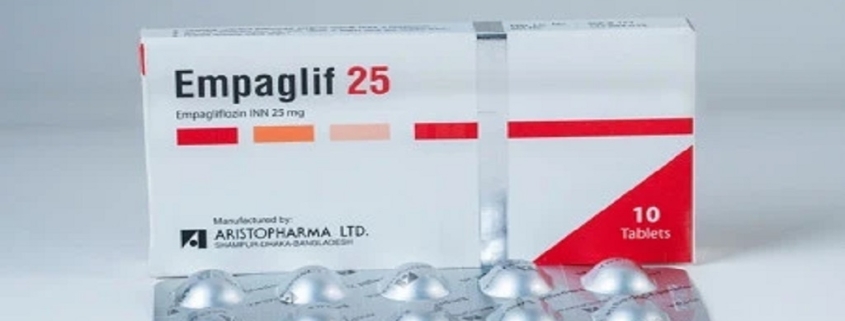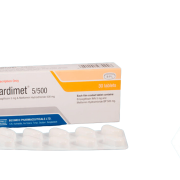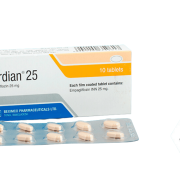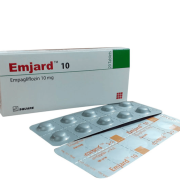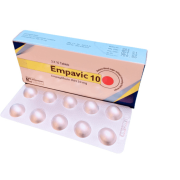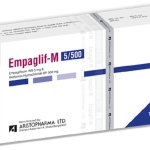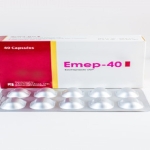Empaglif (Empagliflozin)
Empagliflozin
Description
Sodium-glucose co-transporter 2 (SGLT2) is the predominant transporter responsible for reabsorption of glucose from the glomerular filtrate back into the circulation. Empagliflozin is an inhibitor of SGLT2. By inhibiting SGLT2, Empagliflozin reduces renal reabsorption of filtered glucose and lowers the renal threshold for glucose, and thereby increases urinary glucose excretion.
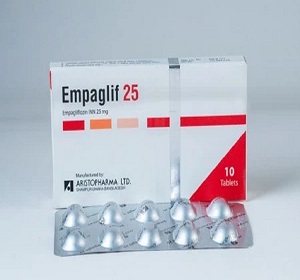
Presentation
Empaglif 10 Tablet: Each box contains 30 tablets in alu-alu blister pack.
Empaglif 25 Tablet: Each box contains 10 tablets in alu-alu blister pack.
Indications
Empaglif is a sodium-glucose co-transporter 2 (SGLT2) inhibitor indicated:
as an adjunct to diet and exercise to improve glycemic control in adults with type 2 diabetes mellitus to reduce the risk of cardiovascular death in adult patients with type 2 diabetes mellitus and established cardiovascular disease.
Dosage & Administration
The recommended dose of Empaglif is 10 mg once daily in the morning, taken with or without food. In patients tolerating Empaglif, the dose may be increased to 25 mg. Do not initiate Empagliflozin or discontinue it, if initiated, when eGFR is below 45 mL/min/1.73 m2.
Contrainidications
Empagliflozin is contraindicated in patients with history of serious hypersensitivity reaction to Empagliflozin. It is also contraindicated in patients with severe renal impairment, end-stage renal disease, or dialysis.
Warning & Precautions
Empagliflozin is contraindicated in patients with history of serious hypersensitivity reaction to Empagliflozin. It is also contraindicated in patients with severe renal impairment, end-stage renal disease, or dialysis.
Side effects
The most common adverse reactions associated with Empagliflozin (5% or greater
incidence) are urinary tract infections and female genital mycotic infections. Other possible adverse reactions include: Hypotension, Ketoacidosis, Acute Kidney Injury, Urosepsis and Pyelonephritis, hypoglycemia, male genital mycotic infections and Increased LDL-C.
Drug interaction
Diuretics: Coadministration of Empagliflozin with diuretics resulted in increased urine volume and frequency of voids, which might enhance the potential for volume depletion. Insulin or Insulin Secretagogues: Coadministration of Empagliflozin with insulin or insulin secretagogues increases the risk for hypoglycemia.
Use in special groups
Pregnancy: Empagliflozin is not recommended during the second and third trimesters of
pregnancy. Limited data available with Empagliflozin in pregnant women are not sufficient to
determine a drug-associated risk for major birth defects and miscarriage.
Lactation: Because of the potential for serious adverse reactions in a breastfed infant,
advise women that use of Empagliflozin is not recommended while breastfeeding.
Pediatric use: The safety and efficacy of Empagliflozin in pediatric patients under 18 years
of age have not been established.
Geriatric use: No dosage change is recommended based on age. The risk of volume
depletion-related adverse reactions & urinary tract infections is increased in patients who are
75 years of age and older.
Renal impairment: The efficacy and safety of Empagliflozin have not been established in
patients with severe renal impairment, with ESRD, or receiving dialysis.
Hepatic impairment: Empagliflozin may be used in patients with hepatic impairment.
Packing
Empaglif 10 Tablet: Each box contains 30 tablets in alu-alu blister pack.
Empaglif 25 Tablet: Each box contains 10 tablets in alu-alu blister pack.

